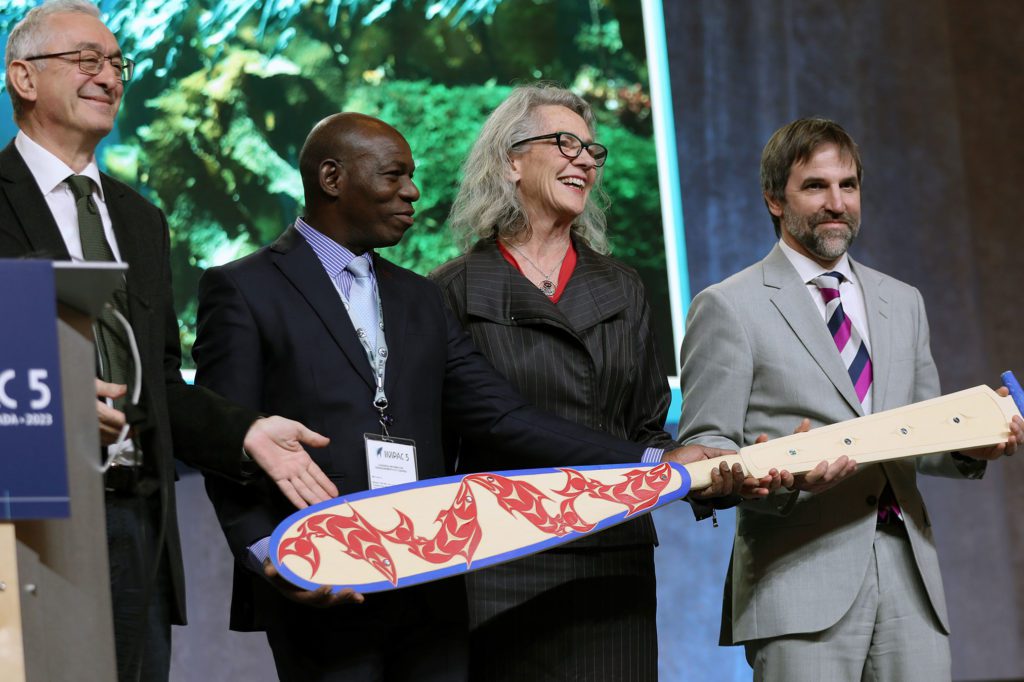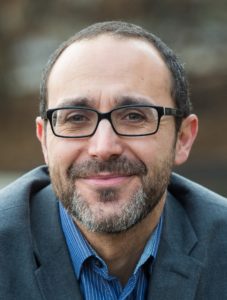Takeaways from IMPAC5 – the 5th International Marine Protected Areas Congress, Canada.
Syexwáliya Ann Whonnock, Squamish Nation elected counsilor - IMPAC5. Photo by IISD/ENB | Anastasia Rodopoulou.
The congress embraced relevant topics such as communities, youth and indigenous peoples´ involvement, sustainable financing for MPAs, sustainable fisheries and several aspects on MPA governance and management.
From February 3rd to the 9th, the 5th International Marine Protected Areas Congress (IMPAC5) opened its doors in Vancouver, Canada. This global forum aims to engage ocean conservation professionals, youth delegates, Indigenous Peoples, authority representatives and other stakeholders from all over the world to exchange knowledge, experiences and best practices to strengthen the conservation of marine biodiversity and the protection of the ocean.
Hosted in the traditional territories of the First Nations’ Squamish, Musqueam, and Tsleil-Waututh Nations, the congress had a strong presence of First Nations and Inuit representatives, who reminded us all that Canada is an ocean nation, with the longest coastline in the world and that protecting of marine ecosystems is key for the nation’s survival. During the opening and in this same line of thought, it was emphasized the vital role that oceans play in people’s lives, both for the services they provide to our society (1) and the deep connection that exists between the ocean and Canada’s culture and economy (2).
The opening ceremony also highlighted that the congress is an official activity of the UN Decade of Ocean Science for Sustainable Development and a contributing act for the implementation of the recently adopted Kunming-Montreal Global Biodiversity Framework.
The Kunming-Montreal Global Biodiversity Framework
The recently agreed upon Kunming-Montreal Global Biodiversity Framework is an important step for global conservation. This framework aims to halt and reverse biodiversity loss and covers marine areas within national jurisdiction and, in the congress, it was recognised as “the most important universal agreement we have”, while it was underscored that there cannot be a healthy planet without a healthy Ocean, and that its health is in decline (3).

Peter Thomson, UN Secretary-General’s Special Envoy for the Ocean – IMPAC5. Photo by IISD/ENB | Anastasia Rodopoulou.
One particular target includes the commitment to protect 30% of the oceans by 2030 (also known as 30×30). However, this is an incredible challenge, as it implies expanding to almost triple the current Marine Protected Areas (MPAs) in the next seven years (4).
In this line, a specific discussion took place on the efficacy of a 30% area target based on a case study on MPAs in the German North Sea, underlining that each MPA is subject to different stressors and therefore requires specific management solutions (5). However, a reminder of our existing lack of knowledge and understanding of extense areas of the oceans such as the high seas and the deep seas, and the necessity to create MPAs on these areas and around the Antarctic, was also presented together with a call to think beyond the 30×30, as protecting 30% of the planet is not going to solve all the world’s problems (6).
Community involvement – Empowering communities to lead the way

Sylvia Earle, Founder and Co-Chair, Mission Blue 1 – IMPAC5. Photo by IISD/ENB | Anastasia Rodopoulou.
Local communities, specifically indigenous communities as the hosts of the land on which the congress took place, were undoubtfully another key topic during the congress. Both local communities and small-scale fisheries have a key role in leading the way on environmental stewardship and marine conservation (7) and it is crucial to incorporate their perspectives and knowledge (8).
The benefits of empowering communities to participate and collaborate in the conservation of resources and livelihoods, as well as to achieve a sustainable management, were also presented through examples from Myanmar (9) and Tanzania (10). Other interesting cases about community led initiatives were presented: A community led coral conservation and restoration activities that include the certification of community coral gardeners in San Andrés, Colombia (11); A monitoring and reporting framework on a marine reserve developed in cooperation with indigenous people in New Zealand (12); An ongoing process to develop a community-based MPA in this southern Chilean archipelago (13).
Sustainable Finances and Sustainable Tourism in MPAs
The integration of science and community-based approaches were also identified as a solution to improve the management and financial sustainability of the MPAs (14). Other examples of blue finance solutions were presented from Onnason, Okinawa, on a mozuku seaweed farming and coral plantation (15).
Sustainable Tourism was also integrated in the conversations. From a financial point of view, an example on the development of a business model based on raising revenue from sustainable tourism in order to support the budget of the Turneffe Atoll Marine Reserve was presented (16). As a counterpart, the efforts undertook to limit the negative to regulate diving tourism in Karimunjawa National Park in the Java Seas, Indonesia, were explained and reminded the participants the negative impacts that tourism activities can pose to marine ecosystems (17).
Challenges in MPA Management and Governance
Some interesting reflections on MPA management and its challenges were brought to the discussion. It is noteworthy to mention the presentations submitted about Gwaii Haanas National Park in Canada, covering an overview of its history over the last 30 years and its main challenges and solutions. In this regard, some conclusions on research studies on measuring co-development of governance indicators to support the implementation of a landsea-people plan in this Park were exposed (18).
Other factors underpinning MPA management were identified as social, economic and ecological elements, as explained in a case study on the management of San Antonio MPA (19). Likewise, , social acceptance of MPAs was identified as another barrier in its implementation and, based on the research outcomes on a generic MPA model, it was concluded that many times the opposition to MPAs is not against conservation, but rather the design and implementation model used (20).
On the other hand, Transboundary Cooperation was also present in the discussion with an example on Transboundary Protected Areas management in the Eastern Tropical Pacific in which the importance of enabling the harmonization of different legal, political, and cultural systems and the necessity to develop of a stronger legal framework for “ecological connectivity” were underscored (21).
Another case study in this line was brought on the work of a civil society network for the conservation of the Patagonian Sea, the challenges they face, and how views should be standardized between decision-makers of different countries to reach effective protection when management extends beyond country boundaries (22).

L-R: Bruno Oberle, Director-General, International Union for Conservation of Nature, Mamadou Sidibé, Director of Community Marine Protected Areas, Senegal, Joyce Murray, Minister of Fisheries, Oceans, and Canadian Coast Guard, and Steven Guilbeault, Minister of Environment and Climate Change, Canada – IMPAC5. Photo by IISD/ENB | Anastasia Rodopoulou.
The importance of Other Effective area-based Conservation Measures (OECMs)
As it was underscored during the congress, OECMs present a unique opportunity for stakeholders to get involved in conservation measures. In this regard a case study on the Baltic Sea in relation to the role of the Regional Sea Conventions, highlighting the need of a cross-sectorial approach to interpret the OECM criteria, was presented (23).
Additionally, reflections on the need to bring the socio-economic sectors into the conservation discussion, to clarify to all stakeholders the differences between MPAs and OECMs (24), the necessity of a clearer understanding of the identification process of OECMs (25) and the facilitating role that NGOs can have were also made (26).
Youth involvement

Sean Russell, IMPAC5 Young Professionals Committee – IMPAC5. Photo by IISD/ENB | Anastasia Rodopoulou.
Youth and their involvement in marine conservation was also one of the topics that stood out during the conference and an IMPAC5 Youth Call to Action was presented during the congress, advocating for a set of youth-determined priorities (27).
Furthermore, the work carried out by Connect to Protect initiative which aims to build a digital community and encourage youth leaders to join the GenSea network to collaborate and nurture a community of youth ocean advocates was exposed (28). Panellists were also invited to reflect on several questions encompassing empowering youth in organizations and hiring them (29).
Further mentions to youth involvement were done in regards of the importance of creating opportunities for children in the school system (30), and of facilitating ways young people can contribute in culturally relevant ways (31).
If you are interested to learn more, we suggest reading the Earth Negotiations Bulletin and listening to the Protecting Blue Nature podcast series.
References to the speakers mentioned in this article can be found below:
(1) Joyce Murray, Minister of Fisheries, Oceans, and the Canadian Coast Guard, Canada.
(2) Amandeep Singh, British Columbia Parliamentary Secretary for Environment, Canada.
(3) Peter Thomson, UN Secretary-General’s Special Envoy for the Ocean, Fiji.
(4) Fanny Douvere from UNESCO’s World Heritage Marine Programme, France.
(5) Benne Wölfing, German Federal Agency for Nature Conservation, Germany.
(6) Sylvia Earle, ocean activists and National Geographic Explorer, United States.
(7) Anthony Charles, Saint Mary’s University, Canada.
(8) Nathalie Ban, University of Victoria, Canada.
(9) Zau Lunn, Flora and Fauna International (FFI), Myanmar.
(10) Tanguy Nicolas, MWAMBAO Coastal Community Network, Tanzania.
(11) Pablo Caldas, Conservation International, Colombia.
(12) Monique Ladds, New Zealand Department of Conservation, New Zealand.
(13) Enrique Higueras, Municipality of Las Guaitecas, Chile.
(14) Grace Gatapang, Blue Alliance Philippines, Philippines.
(15) Masanori Kobayashi from the Sasakawa Peace Foundation, Japan.
(16) Valdemar Andrade, Turneffe Atoll Sustainability Association, Belice.
(17) Rohmani Sulisyati, Karimunjawa National Park, Indonesia.
(18) Ella-Kari Muhl, University of Waterloo, Canada.
(19) Veronica Relano, University of British Columbia, Canada.
(20) Anne Cadoret, Aix-Marseille University, and Jean-Eudes Beuret, Rennes Agro Institute, France.
(21) Sarah Enright, University College Cork, Ireland.
(22) Catherine Dougnac, Wildlife Conservation Society, Chile.
(23) Jannica Haldin, HELCOM, Finland.
(24) Souha El Asmi, UNEP-MAP, Tunisia.
(25) Felipe Paredes, Ministry of Environment of Chile.
(26) Johnny Briggs, The Pew Charitable Trust, United Kingdom.
(27) Sean Russell, IMPAC5 Young Professionals Committee, Canada.
(28) Amelia Fortgang, EarthEcho, United States.
(29) Joseph Mcleod, Parks Canada, Canada.
(30) Jenn Stevens, Learning for Sustainable Futures, Canada.
(31) Joshua Komangapik, Students on Ice, Canada.
European Charter for Sustainable Tourism – 12th Network Meeting
Every two years, the EUROPARC Sustainble Tourism Network comes together to share best practice, learn and connect with peers. This year, the network will meet in Bled, Slovenia.
Visitor monitoring in Protected Areas
- 16 – 18 May (Arrival on the 15th, departure on the 19th)
- Infocenter Triglavska Roža Bled, Ljubljanska cesta 27, 4260 Bled, Slovenia
Managing visitors in Protected Areas is becoming more and more complex. Visitor numbers seem to be growing unlimitedly all over Europe, as well as the number of new recreational forms, that irrupt season after season. This rise in visitor numbers and activities takes a toll not only on the natural environment, but also on the local communities and visitors’ own experience.
Protected Areas managers are confronted with the challenging decision of how to best protect the natural environment while not compromising the visitor experience. Thus, good visitor monitoring systems and tools, – both in terms of quality and quantity – are essential for making sound decisions on visitor management.
Moreover, we will have the opportunity to discover directly from the field how unique Slovenia’s National Park and oldest Biosphere Reserve in the country is managing the rapid and dramatic rise in visitor numbers. In the space of eight years, visitation in Triglav National Park has increased more than five-fold, which has created several environmental, nature conservation, and sociological issues.
Besides, there will be plenty of opportunities to network and share experiences, learn from each other, and get new ideas to take back to your areas, including an “open mic” session, in which you can bring a 5 minutes presentation of your project, ideas for projects, looking for partners, or just raising general sustainable tourism questions you want advice on from the audience.
Furthermore, we will have the unique opportunity to understand how transboundary cooperation is made possible regarding managing visitors and many other topics between the Triglav National Park (SLO) and Parco Naturale Prealpi Giulie (IT) in the Transboundary Ecoregion Julian Alps, a Transboundary Sustainable Destination.
Download the full programme here
Practical information
Bled is generally relatively easy to reach with different forms of public transport. More details can be found in the programme. We encourage you to book accommodation as soon as possible, as the 18th of May is a public holiday in some countries (Ascension Day). Some information on accommodation can be found here.
- Fee: 250 Euros. This covers the participation in the whole event, including meals and field trips.
- Registration closed on the 15th of April
Conference: Greening Towards Urban Resilience
The LIFE UrbanGreeningPlans project is coming to an end! To share the wealth of experience collected by the participating cities and Periurban Parks, project partners are excited to invite you to the closing conference in Barcelona.
About the Conference “Greening Towards Urban Resilience”
- Date: 14 – 15 March
- Location: Citilab Cornellà (https://www.citilab.eu/), Plaça de Can Surís, s/n, 08940, Cornellà de Llobregat
Nature-based Solutions can support urban areas in responding and adapting to climate change. To do so efficiently, learning from Periurban Parks, working across city departments and communicate efficiently is essential. The different project partners of the programme have been working across these areas to lead the way in urban greening. This work, accompanied by expert interventions and field trips, await participants of the conference. Participation is free of charge.
At this final conference of LIFE UrbanGreeningPlans, we will bring together people from different disciplines to reflect on urban greening, sharing best practice case studies and working towards a common framework. To do so, we will take into account multiple scales and angles. We will consider a wide range of urban ecosystems, from urban forests, parks, blue and green corridors, to others. Furthermore, we will consider the actual contexts of climate change, rapid urbanization and social uncertainty.
- How can we further enhance ecosystem services in our cities?
- How can green spaces contribute to urban resilience?
- How can we incorporate urban greening at different levels of government?
Those are the questions we will answer during this high-level event.
During two days, Conference participants will enjoy a highly interactive programme. From the presentation of the different project actions in the cities of Athens, Barcelona, Brussels, Milan and Lisbon, to thought-provoking keynote speakers, the event will have no shortage of inspiration for decision makers and urban planners across Europe.
Check out the programme (English)
Check out the programme (Catalan)
Registration has closed! If you have not received a confirmation email please contact:


Next EUROPARC Webinar: Four benefits of better sustainability marketing and communication
Join this webinar with Dr Xavier Font on the 23rd of February.
Four benefits of better sustainability marketing and communication – Tips for rural businesses
- 23.02, from 10:00 – 11:00 CET
- Attendance is free, but registration is necessary
There are many rural tourism and hospitality businesses that already protect their environment and create meaningful jobs, purchase locally and promote a sense of belonging. These businesses may not be making the most of their sustainability practices because they are not aware of how they can effectively communicate them, or because they have unrealistic expectations of what such a label can achieve. It is time to learn how to communicate your sustainability in a way that makes sense to your customers.
In this webinar, Dr Xavier Font, professor of Sustainability Marketing at the University of Surrey, United Kingdom will demonstrate how sustainable businesses can better market and communicate what makes them different, by focusing on how it makes their customer’s experience more complete. We will brainstorm realistic ideas that you can adapt, relevant to the decisions your customers need to take, that will help reassure them that you are the right company for their needs. Without idealism, jargon and ‘save the planet’ messages.
The webinar will focus on the four benefits of better sustainability marketing and communications for rural tourism businesses. Furthermore, we will look at tips to reduce your operating costs, improve your customer satisfaction, increase their expenditure, as well as their loyalty.
This webinar is a follow-up on a successful webinar organised last October. In the previous webinar, Dr Font detailed how small businesses and destination managers can design and market sustainable experiences during the low season.
Webinar Programme
Welcome and Introductions
Teresa Pastor, ECST Manager at EUROPARC Federation.
Creating better sustainability marketing for your business
Dr Xavier Font.
Let’s talk about it!
Participants will have the chance to pose questions.
The webinar will last 1 hour.
About the speaker

Dr Font researches and develops methods of sustainable tourism production and consumption. He has published widely about sustainable tourism certification, and has consulted on sustainable product development, marketing and communication. He currently serves as an advisor in Prince Harry’s Travalyst coalition of Booking.com, Tripadvisor, Google, Expedia, Skyscanner, Visa and Trip. Furthermore, he has conducted over 150 courses for more than 5,000 businesses on how to market and communicate sustainability. He is currently the Principal Investigator for the University of Surrey for the €23m Interreg project “EXPERIENCE”, which aims to develop low season sustainable tourism visitor experiences.
